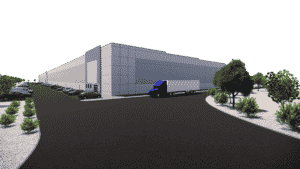
Industrial projects under way south of Boston include the 345,000-square-foot Lincoln Logistics 36 facility in Bellingham developed by Lincoln Property Co. and Barings. Image courtesy of Lincoln Property Co.
The impacts of the COVID-19 pandemic are still rippling through both the local and national commercial real estate markets. That said, the industrial asset class has continued to outperform despite current conditions as growth in e-commerce, biomanufacturing and other on-shoring operations are driving tenant demand.
While Greater Boston is considered a secondary or tertiary logistics market, the metro has benefitted from historically strong fundamentals over the last few years. With record-low vacancies and rapidly rising rents, developers are ramping up speculative construction throughout the region, while a lack of modern, high-bay warehouse product is supporting build-to-suit activity.
Unlike in many urban markets, such as Boston and Cambridge, COVID-19 appears to have had less of an impact on construction in suburban and exurban locations where the bulk of new industrial deliveries are concentrated. Total square footage underway in the Greater Boston industrial market surpassed 2 million square feet at the end of last year, which represents the highest level in 15 years.
The planning pipeline continues to grow as well, and development sites remain highly sought-after investment opportunities. The outlook for the local industrial market remains decidedly positive with 10 to 12 million square feet of future demand in the queue. This outsized demand, coupled with limited building availabilities, high rents and growing investor interest, will continue to attract developers to Greater Boston.
Developers Gravitate to South Suburbs
As the logistics hub of Greater Boston, the south industrial markets have garnered the bulk of tenant demand and new construction. In fact, roughly 64 percent of all projects currently under way are located south of Boston. Key projects include the 345,000-square-foot Lincoln Logistics 36 in Bellingham, the 350,000-square-foot 1025 Elm St. at the Cabot Commerce Center in Bridgewater and two buildings totaling 345,000 square feet at the Bluestar Business Park in Norton.
Biomanufacturing operations have grown in importance as well as concerns over COVID-19-related supply chain disruptions linger. With more than 1 million square feet of requirements in the market, locations within an hour of Cambridge are in high demand for production facilities.
Much of this recent activity has also been concentrated in the south industrial markets. Moderna Therapeutics completed a 200,000-square-foot good manufacturing practices (GMP) facility in Norwood roughly two years ago while Alnylam Pharmaceuticals is building its own 200,000-square-foot facility in Norton. Thermo Fisher’s planned 290,000-square-foot production facility in Plainville, however, is the most recent example of this trend.
As the region’s life science sector continues to grow, look for more activity in this niche product type, particularly as some biotech firms look to onshore some of their production operations.
Construction Pushes Further Out
Construction activity also continues to push further out from Boston’s urban core.
A resurgence in urban living and working attracted new office, multifamily, life science and other mixed-use projects to places like Boston, Allston-Brighton, Cambridge and Somerville. Accordingly, urban industrial product began to face pressures from developers looking to repurpose these properties to meet the need for new housing and commercial space.
Access to low-cost labor, indicative of many industrial users, has also become scarce due to growing wages and Boston’s high costs of living. With rising costs, fewer developable parcels and shallow labor pools, developers – with a particular focus on the warehouse/distribution product type – have become quite active on the fringes of what is considered the Boston metro area.

Liz Berthelette
Worcester County, southern New Hampshire and Bristol County (which is technically considered part of the Providence metro) have all witnessed an increase in industrial development as landlords look to save on land costs and tap into tenants seeking cheaper lease rates. Campanelli has large projects in Uxbridge and Freetown. Southwest of Worcester, Hillwood and GFI Partners recently announced plans for 1.27 to 1.5 million square feet at the Charlton Commerce Center in Charlton. There are also several major projects planned in places like Carver, Boylston, Douglas and Lunenburg.
The local industrial market shows no sign of slowing despite the coronavirus outbreak and developers will need to add more product to Greater Boston’s inventory in order to meet current demand projections. The scarcity of developable land and high operating costs will likely keep new construction migrating beyond the metro area boundaries and into neighboring tertiary markets.
Liz Berthelette is research director at Newmark Knight Frank in Boston.






